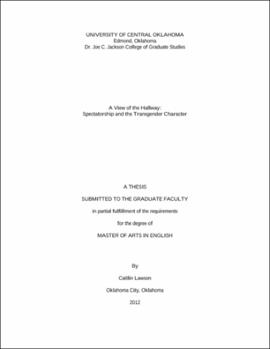| dc.contributor.advisor | Springer, John Parris, 1955- | |
| dc.contributor.author | Lawson, Caitlin | |
| dc.date.accessioned | 2020-05-26T20:39:12Z | |
| dc.date.available | 2020-05-26T20:39:12Z | |
| dc.date.issued | 2012 | |
| dc.identifier.other | (AlmaMMSId)9978444685202196 | |
| dc.identifier.uri | https://hdl.handle.net/11244/324706 | |
| dc.description.abstract | This thesis aims to reevaluate theories of the spectatorial gaze in light of films that feature transgender characters. Such theories, in particular those of Laura Mulvey, Mary Ann Doane, and Teresa de Lauretis, rely on strict sex and gender binaries to explain the pleasure that comes from watching films. However, transgender characters disrupt such binaries and allow for new ways of seeing. Using feminist theories of sex and gender, most notably Judith Butler's theory of gender performativity, queer theory and feminist theories of spectatorship, this thesis explores the effects of the transgender character on film spectators by providing close readings of The Birdcage, Victor/Victoria, Transamerica, and Boys Don't Cry. The Birdcage explores the key tension between the reification and subversion of stereotypes inherent in drag performance, and Armand and Albert's gender performances allow for a spectatorial position that is individualized rather than determined by the sex and gender of the spectator. Although Victor/Victoria contains elements of gender transgression through its exposure of gender as a performance and its disruption of the spectatorial gaze, King and Victoria's relationship undermines the radical potential of the film by reinscribing Victoria as a vulnerable, submissive woman. By foregrounding the spectatorial gaze and reworking the Oedipal scenario, Transamerica ultimately argues that the borders of male/female, masculine/feminine, and mother/father are false dichotomies. Finally, although Lana's understanding of and relationship with/to Brandon's body fluctuates throughout the film, Boys Don't Cry ultimately preserves the complexity of the transgender body through Lana's gaze. Such findings call for further investigation of the effect of atypically-gendered characters on film spectatorship. | |
| dc.rights | All rights reserved by the author, who has granted UCO Chambers Library the non-exclusive right to share this material in its online repositories. Contact UCO Chambers Library's Digital Initiatives Working Group at diwg@uco.edu for the permission policy on the use, reproduction or distribution of this material. | |
| dc.subject.lcsh | Transgender people in motion pictures | |
| dc.subject.lcsh | Gender identity in motion pictures | |
| dc.title | A view of the hallway : spectatorship and the trandsgender character | |
| dc.type | Academic theses | |
| dc.contributor.committeeMember | Brodnax, Mary Margaret | |
| dc.contributor.committeeMember | Macey, J. David | |
| dc.thesis.degree | M.A., English | |
| dc.identifier.oclc | (OCoLC)ocn835665206 | |
| uco.group | UCO - Graduate Works and Theses::UCO - Theses | |
| thesis.degree.grantor | Jackson College of Graduate Studies | |
